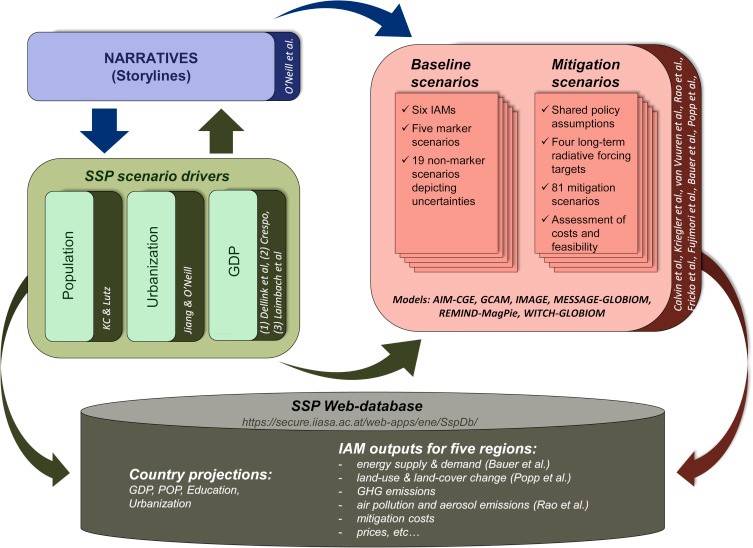Shared Socioeconomic Pathways: Finding routes to sustainability
How will the challenges of climate change evolve given the different social, political, and economic paths that the world might take? The Shared Socioeconomic Pathways provide possible narratives, allowing the climate research community to systematically compare their projections and develop robust policy advice. These pathways were the subject of a 2016 special issue of the journal Global Environmental Change, compiled by the IIASA Energy Program and partners.
The Shared Socioeconomic Pathways (SSPs) are five possible paths human societies could follow over the next century. Designed by and for the climate change research community to use as a basis for their models, the SSPs span a wide range of feasible future developments in areas such as population, the economy, and agriculture.
The pathways were developed in recent years to describe plausible major global developments that together would lead to different challenges for mitigation and adaptation to climate change. The SSPs are based on five narratives describing alternative socioeconomic developments, known as: sustainable development, regional rivalry, inequality, fossil-fueled development, and middle-of-the-road development.
Analyzing the different ways to mitigate climate change as part of the special issue, the researchers found that the costs of mitigation were lowest in the sustainable development and inequality scenarios and highest in the fossil-fueled development and regional rivalry pathways.
Perhaps most importantly, the studies find that not all targets are necessarily attainable from all of the pathways. Specifically, keeping temperature change to about 2oC was not feasible when following the regional rivalry pathways. This narrative describes a possible future where resurgent nationalism, concerns about competitiveness and security, and regional conflicts push countries to increasingly focus on domestic or, at most, regional issues.
The next steps of the process, organized as part of the Scenario Model Intercomparison Project [1], will involve collaboration with the climate modeling teams of the Coupled Model Intercomparison Project 6 [2] to assess the climate consequences of the SSPs. The work also provides important services to the research community, including a detailed modeling protocol for integrated assessment modeling teams to enable widespread participation in quantifying the SSPs.
The main steps in developing the SSPs, including the narratives, socioeconomic scenario drivers (basic SSP elements), and SSP baseline and mitigation scenarios.
Most importantly, the SSPs enable researchers to explore climate change impacts, adaptation, and vulnerability under a range of possible socioeconomic developments and climate change projections. The pathways provide a common grounding so that a large body of literature based on comparable assumptions can emerge.
References
[1] O’Neill B C, Tebaldi C, van Vuuren D P, Eyring V, Friedlingstein P, Hurtt G, Knutti R, Kriegler E, Riahi K et al. (2016). The Scenario Model Intercomparison Project (ScenarioMIP) for CMIP6. Geoscientific Model Development 9 (9): 3461-3482.
[2] O’Neill BC, Kriegler E, Ebi KL, Kemp-Benedict E, Riahi K, Rothman DS, van Ruijven BJ, van Vuuren DP, et al. (2017). The roads ahead: Narratives for shared socioeconomic pathways describing world futures in the 21st century. Global Environmental Change 42: 169-180.
[3] Riahi K, van Vuuren DP, Kriegler E, Edmonds J, O’Neill B, Fujimori S, Bauer N, Calvin K, et al. (2017). The shared socioeconomic pathways and their energy, land use, and greenhouse gas emissions implications: An overview. Global Environmental Change 42: 153-168.
[4] KC S & Lutz W (2017). The human core of the shared socioeconomic pathways: Population scenarios by age, sex and level of education for all countries to 2100. Global Environmental Change 42: 181-192.
[5] Crespo Cuaresma J (2017). Income projections for climate change research: A framework based on human capital dynamics. Global Environmental Change 42: 226-236.
[6] Fricko O, Havlik P, Rogelj J, Klimont Z, Gusti M, Johnson N, Kolp P, Strubegger M, et al. (2017). The marker quantification of the Shared Socioeconomic Pathway 2: A middle-of-the-road scenario for the 21st century. Global Environmental Change 42: 251-267.
[7] Fujimori S, Hasegawa T, Masui T, Takahashi K, Herran DS, Dai H, Hijioka Y, Kainuma M. SSP3: AIM implementation of Shared Socioeconomic Pathways. Global Environmental Change 42: 268–283.
[8] Bauer N, Calvin K, Emmerling J, Fricko O, Fujimori S, Hilaire J, Eom J, Krey V, et al. (2017). Shared Socioeconomic Pathways of the Energy Sector – Quantifying the Narratives. Global Environmental Change 42: 316-330.
[9] Popp A, Calvin K, Fujimori S, Havlik P, Humpenöder F, Stehfest E, Bodirsky BL, Dietrich JP, et al. (2017). Land-use futures in the shared Socioeconomic pathways. Global Environmental Change 42: 331-345.
[10] Rao S, Klimont Z, Smith SJ, Van Dingenen R, Dentener F, Bouwman L, Riahi K, Amann M, et al. (2017). Future air pollution in the Shared Socioeconomic Pathways. Global Environmental Change 42: 346-358.

